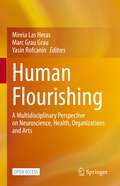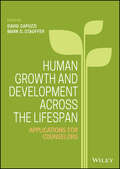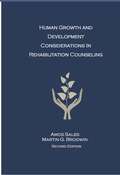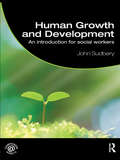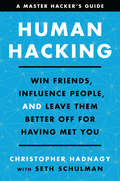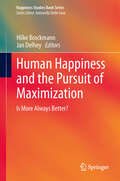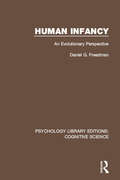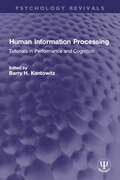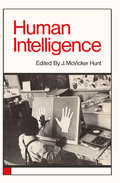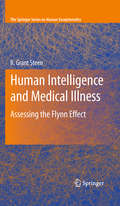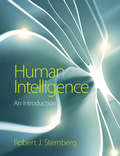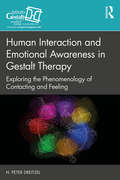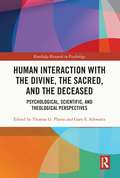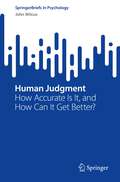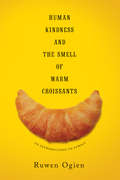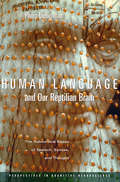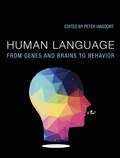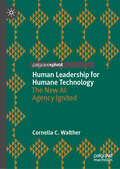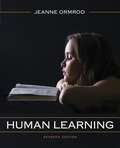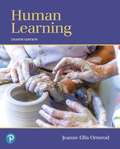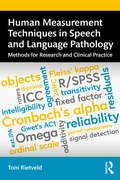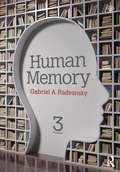- Table View
- List View
Human Flourishing: A Multidisciplinary Perspective on Neuroscience, Health, Organizations and Arts
by Marc Grau Grau Yasin Rofcanin Mireia Las HerasThis open access book presents a novel multidisciplinary perspective on the importance of human flourishing. The study of the good life or Eudaimonia has been a central concern at least since Aristotelian times. This responds to the common experience that we all seek happiness. Today, we are immersed in a new paradoxical boom, where the pursuit of happiness seems to permeate everything (books, media, organizations, talks), but at the same time, it is nowhere, or at least very difficult to achieve. In fact, it is not easy to even find a consensus regarding the meaning of the word happiness. Seligman (2011), one of the fathers of the positive psychology, confirmed that his original view the meaning he referred to was close to that of Aristotle. But, he recently confessed that he now detests the word happiness, since it is overused and has become almost meaningless. The aim of this open access book is to shed new light on human flourishing through the lenses of neurosciences and health, organizations, and arts. The novelty of this book is to offer a multi-disciplinary perspective on the importance of human flourishing in our lives. The book will examine further how different initiatives, policies and practices create opportunities for generating human flourishing.
Human Growth and Development Across the Lifespan
by David Capuzzi Mark D. StaufferA practically focused guide to effective counseling of all clients Human Development Across the Life Span is a practical guide to human growth and development, moving beyond theory to include real-world applications for counselors who work with clients. Written by recognized authorities in mental health counseling and counselor education, this book is fully aligned with the American Counseling Association's accreditation standards and includes contributions by well-known and respected academics and practitioners. Based on an extensive review of course syllabi across CACREP-accredited programs, this book is organized to follow the way courses are typically taught and follows a consistent structure including pedagogical elements that help students learn. After a thorough examination of essential concepts and theories of life span development, the book moves through each stage of human growth and development to provide expert insight, short case studies, and practical applications to counseling. The full Instructor's package provides a useful set of tools, including a Respondus test bank, PowerPoint slides, and an Instructor's Manual. This book is the only text on human growth and development that emphasizes the key implications and applications for counselors, providing useful information and the insights of real experts in each subject area. Understand the developmental milestones at each life stage Appreciate clients' perspectives to better facilitate appropriate interventions Work more effectively with clients of any age, from toddlers to seniors Tailor your approach to meet the unique needs and abilities of each life stage As a counselor, you cannot approach a child's therapy the same way you approach an adult's. Even within each major category, each developmental stage includes a nuanced set of characteristics that, considered appropriately, will inform a more effective treatment plan. Human Development Across the Life Span is a comprehensive guide to understanding all of your clients, and providing the type of counseling that facilitates more positive outcomes.
Human Growth and Development in Rehabilitation Counseling
by Martin G. Brodwin Amos SalesHuman Growth and Development in Rehabilitation Counseling, 2nd Edition
Human Growth and Development: An Introduction for Social Workers (Student Social Work)
by John SudberySocial workers work with people at all stages of life, tackling a multitude of personal, social, health, welfare, legal and educational issues. As a result, all social work students need to understand human growth and development throughout the lifespan. This introductory text provides a knowledge base about human development from conception to death. It is designed to encourage understanding of a wide range of experiences, including some very difficult ones, such as child abuse, the developmental trajectories of children in care, mental distress, the experience of people with dementia, the experience of torture victims and untimely bereavements. Using engaging narratives to illustrate real-life situations, the author analyses them to demonstrate the link between theory, and different theoretical approaches, and practice. Packed with case studies, this student-friendly book includes overviews, summaries, questions and further reading in each chapter as well as a more formal academic section designed to challenge and intrigue students. A reference section contains a glossary and overviews of the principal theories discussed throughout the book. It is an essential read for all social work students.
Human Hacking: Win Friends, Influence People, and Leave Them Better Off for Having Met You
by Christopher Hadnagy Seth SchulmanA global security expert draws on psychological insights to help you master the art of social engineering—human hacking. Make friends, influence people, and leave them feeling better for having met you by being more empathetic, generous, and kind.Eroding social conventions, technology, and rapid economic change are making human beings more stressed and socially awkward and isolated than ever. We live in our own bubbles, reluctant to connect, and feeling increasingly powerless, insecure, and apprehensive when communicating with others.A pioneer in the field of social engineering and a master hacker, Christopher Hadnagy specializes in understanding how malicious attackers exploit principles of human communication to access information and resources through manipulation and deceit. Now, he shows you how to use social engineering as a force for good—to help you regain your confidence and control. Human Hacking provides tools that will help you establish rapport with strangers, use body language and verbal cues to your advantage, steer conversations and influence other’s decisions, and protect yourself from manipulators. Ultimately, you’ll become far more self-aware about how you’re presenting yourself—and able to use it to improve your life. Hadnagy includes lessons and interactive “missions”—exercises spread throughout the book to help you learn the skills, practice them, and master them. With Human Hacking, you’ll soon be winning friends, influencing people, and achieving your goals.
Human Happiness and the Pursuit of Maximization: Is More Always Better?
by Hilke Brockmann Jan DelheyThis book tests the critical potential of happiness research to evaluate contemporary high-performance societies. These societies, defined as affluent capitalist societies, emphasize competition and success both institutionally and culturally. Growing affluence improves life in many ways, for a large number of people. We lead longer, safer, and more comfortable lives than previous generations. But we also live faster, and are competition-toughened, like top athletes. As a result, we suspect limits and detect downsides of our high-speed lives. The ubiquitous maximization principle opens up a systematic gateway to the pleasures and pains of contemporary life. Using happiness as a reference point, this book explores the philosophical and empirical limits of the maximization rule. It considers the answer to questions such as: Precisely, why did the idea of (economic) maximization gain so much ground in our Western way of thinking? When, and in which life domains, does maximization work, when does it fail? When do qualities and when do quantities matter? Does maximization yield a different (un)happiness dividend in different species, cultures, and societies?
Human Identity and Identification
by Rebecca Gowland Tim ThompsonFew things are as interesting to us as our own bodies and, by extension, our own identities. In recent years, there has been a growing interest in the relationship between the body, environment and society. Reflecting upon these developments, this book examines the role of the body in human identification, in the forging of identities, and the ways in which it embodies our social worlds. The approach is integrative, taking a uniquely biological perspective and reflecting on current discourse in the social sciences. With particular reference to bioarchaeology and forensic science, the authors focus on the construction and categorisation of the body within scientific and popular discourse, examining its many tissues, from the outermost to the innermost, from the skin to DNA. Synthesising two, traditionally disparate, strands of research, this is a valuable contribution to research on human identification and the embodiment of identity.
Human Infancy: An Evolutionary Perspective (Psychology Library Editions: Cognitive Science #11)
by Daniel G. FreedmanOriginally published in 1974, this volume is primarily devoted to what is known about human infancy from an ethological, evolutionary viewpoint. Included are discussions of pan-specific traits, presumably shared by all infants; individual genetic variations on these behaviours (as judged by twin-studies); sex differences, presumably shared by infants of all ethnic groups; and genetically based ethnic differences. However, the author favours neither biological determinism nor cultural determinism, and does not consider ‘interactionism’ to be a viable solution. Instead, a monistic position is taken, stressing the inseparability of the innate and the acquired, of genetics and environment, and of biology and culture. The heredity-environment issue is tackled head-on throughout the volume. The interaction between the two (an implied dualism) is described as a statistical abstraction from measured populations, while the position here is that heredity and environment are not separable in any single organism. In the same vein, the author argues that on logical grounds everything one does, every ‘cultural’ act, has within it some biological component.
Human Information Processing: Tutorials in Performance and Cognition (Psychology Revivals)
by Barry H. KantowitzOriginally published in 1974, this volume presents seven detailed views of human information processing at the time. While no single volume can do justice to the breadth of the area, it was hoped that the present selections reflected both the content and methodological approaches currently used by experimental psychologists concerned with the issues and problems of human information processing. The organization of the book is simple, proceeding from the human performance end of the continuum, an overview of which is given in the first chapter. Successive chapters are progressively more concerned with human cognition, and the last chapter gives an overview of human cognition. The intervening chapters are devoted to more specific topics and yield a detailed portrait of the models, findings, and methodology of human information processing.
Human Intelligence
by Earl HuntThis book is a comprehensive survey of our scientific knowledge about human intelligence, written by a researcher who has spent more than 30 years studying the field, receiving a Lifetime Contribution award from the International Society for Intelligence. Human Intelligence takes a non-ideological view of a topic in which, too often, writings are dominated by a single theory or social viewpoint. The book discusses the conceptual status of intelligence as a collection of cognitive skills that include, but also go beyond, those skills evaluated by conventional tests; intelligence tests and their analysis; contemporary theories of intelligence; biological and social causes of intelligence; the importance of intelligence in social, industrial, and educational spheres; the role of intelligence in determining success in life, both inside and outside educational settings; and the nature and causes of variations in intelligence across age, gender, and racial and ethnic groups.
Human Intelligence
by J. McVicker HuntWhat determines human intelligence? What is its relationship to creativity? Its potential for change? To illuminate some of these questions, J. McVicker Hunt has gathered together a number of essays. This volume contains some of the answers that have been found, but emphasizes that we still need to learn a great deal about developing ways to assess our human resources. We remain. for example, uncertain about what abilities pinpoint intelligence, and the extent to which intellectual ability can predict classroom successw-even the ability to perfrom a job well., Articles in this book show that indications of heritability have nothing to say about the educability of individuals or classes w races. Investigations indicate that there is a great deal more plasticity in the development of behavior and abilities than was presumed by those who believe in predetermined intelligence. They also indicate that knowledge and ability both grow during the early years; knowledge grows throughout life: but the ability to acquire new knowledge and skill declines over time., These areas of developing knowledge are of political as well as social significance. Any attempts to upgrade the abilities of the poor or the disadvantaged must necessarily be concerned with manipulation of the environment. These articles represent the most advanced available information about the relationship of experience, environment and heredity to the development of measurable intelligence.
Human Intelligence and Medical Illness
by R. Grant SteenThere's little doubt that people are growing smarter. This effect is so strong that IQ tests must be renormed periodically to prevent classifying an overabundance of people as geniuses. The question is why is this collective rise in IQ - known as the Flynn effect -occurring? Possible theories to explain the Flynn effect have ranged from better parenting to faster evolution. Bringing a bold new voice to the debate, Human Intelligence and Medical Illness sets out a simple definition of intelligence that is appropriate for assessing intelligence at the population level. The definition is then used to probe the relationship between population intelligence and public health. This volume uses the latest medical and behavioral science research to argue that declines in serious disease and illness-causing conditions (e.g., lead paint in buildings) correlate strongly with continued cognitive gains in both developed and developing countries. Current political realities explain why the Flynn effect should be approached as a public policy as well as a public health issue. This provocative volume: Reviews the most widely held hypotheses accounting for the Flynn effect. Examines the relationship between intelligence and public health. Assesses the extent to which public health improvements can potentially account for the Flynn effect. Details how treatment of common medical problems may result in a substantial rise in IQ. Explores the possibility of continued IQ gains in the United States and worldwide. Reframes the Flynn effect in the contexts of public health, early childhood education, and social justice. With its groundbreaking findings on the causes of cognitive impairment and the possibility of cognitive improvement, Human Intelligence and Medical Illness is must-reading for researchers, professors, and graduate students in developmental psychology, education, public health, psychiatry, neuroscience, social work, and related fields.
Human Intelligence: An Introduction (Encyclopedia Of Human Intelligence Ser. #Vol. 2)
by Robert J. SternbergHuman Intelligence is the most comprehensive, current, and readable textbook available today. Written by leading experts in the field, the text includes IQ-test-based, biological, cognitive, cultural, and systems-based perspectives. It also addresses genetic and environmental influences, extremes of intelligence, group differences, lifespan development, the relationship of intelligence and other psychological attributes, and educational interventions. Specific pedagogical features make the text ideal for teaching. Introductions briefly preview what is to come in each chapter. Key terms and concepts are bolded and defined in the text as they are introduced and also found in a glossary at the end of the book. Chapter summaries highlight major points of each chapter, and comprehension and reflection questions help students check their understanding of the material they have just read. Each chapter also includes a 'Focus on Contemporary Research' box that describes in vivid detail the chapter author's current research. A rich program of tables, figures, photos, and samples from research tools throughout help students understand the material in a concrete way.
Human Interaction and Emotional Awareness in Gestalt Therapy: Exploring the Phenomenology of Contacting and Feeling (The Gestalt Therapy Book Series)
by H. Peter DreitzelIn Human Interaction and Emotional Awareness in Gestalt Therapy H. Peter Dreitzel explores a model of the contacting processes between human beings and their environments and presents a phenomenological exploration of the emotions guiding such contacts. The book makes an important contribution to our understanding of the role of psychotherapy in the modern world, especially in the context of change and crisis. Dreitzel sets out a new perspective of how we interact with each other, how we frame our encounters and differentiate them from one another, how we give them meaning, and how they are related to our needs and wants. This is followed by a unique phenomenological exploration of the emotions guiding such contacts, the first time the world of human feelings has been explored in depth and systematically analysed in Gestalt thought. These innovative explorations are framed first by a discussion of the historical development of Western conventions regarding everyday behaviour, and secondly by an examination of perspectives on climate change. Dreitzel analyses the mental and emotional states of potential clients as they are affected by these global processes and the book also includes an epilogue which evaluates how to work with climate anxiety. Dreitzel’s conception of social change, with Gestalt therapy at its core, is relevant to all aspects of humanistic psychology. It elevates empathy, emotional development and the prevention of suffering at all levels of society, filling important gaps in Gestalt therapy theory and expanding it into exciting new territory. Human Interaction and Emotional Awareness in Gestalt Therapy also contains an insightful foreword by Michael Vincent Miller, PhD, and will be essential reading for Gestalt therapists, other professionals with an interest in Gestalt approaches and readers interested in social interaction, climate change and the role of psychotherapy in a changing world.
Human Interaction with the Divine, the Sacred, and the Deceased: Psychological, Scientific, and Theological Perspectives (Routledge Research in Psychology)
by Gary E. Schwartz Thomas G. PlanteHuman Interaction with the Divine, the Sacred, and the Deceased brings together cutting-edge empirical and theoretical contributions from scholars in fields including psychology, theology, ethics, neuroscience, medicine, and philosophy, to examine how and why humans engage in, or even seek spiritual experiences and connection with the immaterial world. In this richly interdisciplinary volume, Plante and Schwartz recognize human interaction with the divine and departed as a cross-cultural and historical universal that continues to concern diverse disciplines. Accounting for variances in belief and human perception and use, the book is divided into four major sections: personal experience; theological consideration; medical, technological, and scientific considerations; and psychological considerations with chapters addressing phenomena including prayer, reincarnation, sensed presence, and divine revelations. Featuring scholars specializing in theology, psychology, medicine, neuroscience, and ethics, this book provides a thoughtful, compelling, evidence-based, and contemporary approach to gain a grounded perspective on current understandings of human interaction with the divine, the sacred, and the deceased. Of interest to believers, questioners, and unbelievers alike, this volume will be key reading for researchers, scholars, and academics engaged in the fields of religion and psychology, social psychology, behavioral neuroscience, and health psychology. Readers with a broader interest in spiritualism, religious and non-religious movements will also find the text of interest.
Human Judgment: How Accurate Is It, and How Can It Get Better? (SpringerBriefs in Psychology)
by John WilcoxWe humans make judgments about a staggering variety of topics. These include which medical condition is the correct diagnosis for your symptoms, whether a particular defendant is guilty of some crime or whether a particular political candidate will win an election—to name a few of countless examples. But how accurate are the judgments we all make, and how can they get better? This book synthesizes interdisciplinary research about these questions into one volume. In doing so, it uniquely draws on insights from fields as diverse as medicine, political judgment, cross-cultural psychology, evolutionary history and the heuristics and biases research program. Consequently, the book also enables readers concerned with judgmental accuracy in one field to benefit from the insights in others. Moreover, the author introduces an emerging field of research: empirical epistemology or normative cognitive science. The book lastly articulates a set of recommendations—recommendations aiming to improve our judgment, our decision-making and ultimately our lives.
Human Kindness and the Smell of Warm Croissants: An Introduction to Ethics
by Ruwen OgienHuman Kindness and the Smell of Warm Croissants makes philosophy fun, tactile, and popular. Moral thinking is simple, Ruwen Ogien argues, and as inherent as the senses. In our daily experiences, in the situations we confront and in the scenes we witness, we develop an understanding of right and wrong as sophisticated as the moral outlook of the world's most gifted philosophers. By drawing on this knowledge to navigate life's most perplexing problems, ethics becomes second nature.Ogien explores, through experimental philosophy and other methods, the responses nineteen real-world conundrums provoke. Is a short, mediocre life better than no life at all? Is it acceptable to kill a healthy person so his organs can save five others? Would you swap a "natural" life filled with frustration, disappointment, and partial success for a world in which all of your needs are met, but through artificial and mechanical means? Ogien doesn't seek to show how difficult it is to determine right from wrong or how easy it is for humans to become monsters or react like saints. Helping us tap into the wisdom and feeling we already possess in our ethical "toolboxes," Ogien instead encourages readers to question moral presuppositions and rules; embrace an intuitive sense of dignity, virtue, and justice; and pursue a pluralist ethics suited to the principles of human kindness.
Human Language and Our Reptilian Brain: The Subcortical Bases of Speech, Syntax, and Thought (Perspectives in Cognitive Neuroscience)
by Philip LiebermanThis book is an entry into the fierce current debate among psycholinguists, neuroscientists, and evolutionary theorists about the nature and origins of human language. A prominent neuroscientist here takes up the Darwinian case, using data seldom considered by psycholinguists and neurolinguists to argue that human language--though more sophisticated than all other forms of animal communication--is not a qualitatively different ability from all forms of animal communication, does not require a quantum evolutionary leap to explain it, and is not unified in a single "language instinct." Using clinical evidence from speech-impaired patients, functional neuroimaging, and evolutionary biology to make his case, Philip Lieberman contends that human language is not a single separate module but a functional neurological system made up of many separate abilities. Language remains as it began, Lieberman argues: a device for coping with the world. But in a blow to human narcissism, he makes the case that this most remarkable human ability is a by-product of our remote reptilian ancestors' abilities to dodge hazards, seize opportunities, and live to see another day.
Human Language: From Genes and Brains to Behavior (The\mit Press Ser.)
by Peter HagoortA unique overview of the human language faculty at all levels of organization.Language is not only one of the most complex cognitive functions that we command, it is also the aspect of the mind that makes us uniquely human. Research suggests that the human brain exhibits a language readiness not found in the brains of other species. This volume brings together contributions from a range of fields to examine humans' language capacity from multiple perspectives, analyzing it at genetic, neurobiological, psychological, and linguistic levels.In recent decades, advances in computational modeling, neuroimaging, and genetic sequencing have made possible new approaches to the study of language, and the contributors draw on these developments. The book examines cognitive architectures, investigating the functional organization of the major language skills; learning and development trajectories, summarizing the current understanding of the steps and neurocognitive mechanisms in language processing; evolutionary and other preconditions for communication by means of natural language; computational tools for modeling language; cognitive neuroscientific methods that allow observations of the human brain in action, including fMRI, EEG/MEG, and others; the neural infrastructure of language capacity; the genome's role in building and maintaining the language-ready brain; and insights from studying such language-relevant behaviors in nonhuman animals as birdsong and primate vocalization.Section editorsChristian F. Beckmann, Carel ten Cate, Simon E. Fisher, Peter Hagoort, Evan Kidd, Stephen C. Levinson, James M. McQueen, Antje S. Meyer, David Poeppel, Caroline F. Rowland, Constance Scharff, Ivan Toni, Willem Zuidema
Human Leadership for Humane Technology: The New AI: Agency Ignited
by Cornelia C. WaltherThis book explores the relationship of natural and artificial intelligence in our rapidly evolving world. It does so anchored in an innovative multidisciplinary framework and the premise that society is a composition of multiple dimensions, with individuals (micro), communities (meso), countries (macro) and planet (meta) in the collective sphere, and individuals themselves as multidimensional beings (aspirations, emotions, thoughts, sensations). This perspective is applied to analyze the implications of our transition into a phase where online and offline realms are increasingly intertwined. Special attention is given to the influence of all pervasive technology on our perception of the self and society. The central message is that we must learn to harness Agency amid AI, which entails double literacy – of artificial and natural intelligence.
Human Learning
by Jeanne OrmrodThe market-leading text on learning theories applied to education, this book draws readers in with a lucid and engaging writing style. It covers a broad range of theoretical perspectives, while including numerous classroom examples of how these theories apply to learning, instruction, and assessment. The market-leading education textbook on learning theories, Human Learning looks at a broad range of theoretical perspectives, including behaviorist, social cognitive, cognitive, constructivist, contextual, and developmental theories. It describes associationistic processes, such as classical and operant conditioning, as well as more complex and distinctly human processes such as metacognition, self-regulated learning, and critical thinking. Using many concrete examples and specific classroom applications, plus a lucid, conversational writing style that truly speaks to students, the author engages students from the start, and makes the concepts, principles, and theories related to human learning and cognition meaningful.
Human Learning
by Jeanne OrmrodOrmrod's engaging, conversational writing style introduces readers to all of the essential learning theories and their real-world classroom implications The market-leading education textbook on learning theories, Human Learning , looks at a broad range of theoretical perspectives, including behaviorist, social cognitive, cognitive, constructivist, cognitive-developmental, sociocultural, and contextual. Each chapter is filled with concrete examples of how these theories apply to learning, instruction, and assessment as well as specific ways readers can apply the theories in their own classrooms. The straightforward, conversational writing style readily engages readers and helps them truly understand the concepts, principles, and theories related to human learning and cognition. The new 8th Edition includes expanded discussions of several contemporary perspectives and a variety of new topics that have emerged in recent research (e.g., motivated reasoning, desirable difficulties). Some discussions of psychological perspectives on learning that have primarily historical value have been either condensed or altogether removed to make room for recent advances in theory and research.
Human Learning and Memory: Advances in Theory and Applications: The 4th Tsukuba International Conference on Memory
by Nobuo Ohta Chizuko IzawaThis text celebrates the fourth Tsukuba International Conference on Memory (Tic4) held in January of 2003, by setting forth productive directions for memory researchers and human learning theorists around the world. It presents fascinating perspectives on progress, and future prospects for models, theories, and hypotheses authors developed, including several new, never published experimental results. Contributors include the winner of the 1997 U.S. Congressional Medal of Science--William K. Estes--who graced the text by penning the forward. The three full day presentations of Tic4 included presentations by 225 experts, represented by 73 universities from countries on four continents: Europe, Asia, Australia, and North America. Human Learning and Memory presents 11 chapters by invited speakers, and its appendices include titles of all papers accepted for Tic4 presentations, as well as a background introduction to Japanese cultures, relevant to Tic4 experiences.This book appeals to scholars, researchers, and teachers in the fields of human learning and memory, cognition, language learning, and educational psychology (theoretical, empirical, and applied dimensions). It can also be used as a textbook for both advanced undergraduate and graduate courses in these domains, either as required or recommended reading.
Human Measurement Techniques in Speech and Language Pathology: Methods for Research and Clinical Practice
by Rietveld ToniHuman Measurement Techniques in Speech and Language Pathology gives an overview of elicitation methods in the assessment and diagnosis of speech and language disorders and explains approaches to the qualification of the obtained data in terms of agreement and reliability. Despite technological advances in the assessment and diagnosis of speech and language disorders, the role of human judgements is as important as ever. Written to be accessible to students, researchers and practitioners alike, the book not only provides an overview of elicitation procedures of human judgement such as visual analog scaling, Likert scaling etc. but also presents methodological and statistical approaches to quality assessment of judgements. The book introduces statistical procedures for processing scores obtained in paired comparisons and in the context of signal detection theory, and introduces software relevant for the calculation of a large number of coefficients of reliability and agreement. Featuring a wealth of reader-friendly pedagogy throughout, including instructions for using SPSS and R software, clarified by many illustrations and tables, example reports, and exercise questions to test the readers understanding, it is an ideal companion for advanced students and researchers in the field of speech pathology.
Human Memory
by Gabriel A. RadvanskyProvides students with a guide to human memory, its properties, theories about how it works, and how studying it can help us understand who we are and why we do the things that we do. For undergraduate and graduate courses in Human Memory. This book provides a very broad range of topics covering more territory than most books. In addition to some coverage of basic issues of human memory and cognition that are of interest to researchers in the field, the chapters also cover issues that will be relevant to students with a range of interests including those students interested in clinical, social, and developmental psychology, as well as those planning on going on to medical and law schools. The writing is aimed at talking directly to students (as opposed to talking down to them) in a clear and effective manner. Not too dense, but also not too conversational as well. This 2nd edition includes a series of exercises that allow the student to try out the concepts and principles conveyed in the chapters, or to use as the basis for exploring their own ideas.
